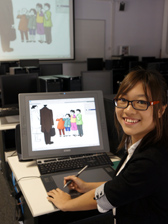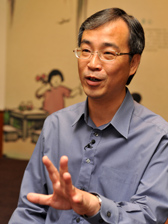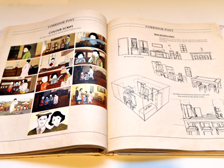
Mastering a master:
Creative media student Rainbow Yuen carefully studied Feng Zikai’s drawing style and the characteristics of his work.
Mastering a master:
Creative media student Rainbow Yuen carefully studied Feng Zikai’s drawing style and the characteristics of his work.

Attraction generator:
Curator Szeto Yuen-kit says the ultimate goal of the exhibition is to promote art education and appreciation, especially among young people.
Attraction generator:
Curator Szeto Yuen-kit says the ultimate goal of the exhibition is to promote art education and appreciation, especially among young people.

Detail driven:
The students paid close attention to every aspect of the animation, using muted colours, and researching clothing and houseware used in Feng Zhikai’s heyday.
Detail driven:
The students paid close attention to every aspect of the animation, using muted colours, and researching clothing and houseware used in Feng Zhikai’s heyday.
Students reignite passion for traditional art
September 02, 2012
Visitors to the Museum of Art exhibit of the father of Chinese cartoons Feng Zikai are in for a double delight. His popular drawings come to life in two short animations painstakingly crafted by creative media students.
It is part of a plan to make traditional Chinese artwork more accessible, particularly to young people, museum curator Szeto Yuen-kit says.
“Who is he?” was the first question on Rainbow Yuen’s mind when she heard the name Feng Zikai. She and her Hong Kong Design Institute classmates were assigned to select some impressive elements in Feng’s comics, to create a short animation which combined the skills they had acquired and the characteristics of Feng’s art.
Ms Yuen understood that she had to first “make friends” with this renowned artist, spending several months with her fellow students studying Feng’s art and his biography.
“We are all fans of Japanese comics but knew nothing about Chinese traditional art. When we looked at Feng Zikai’s comics, we were taken with the elements of family and children they contain. Based on this, we created a story about children pretending to be Mom and Dad and doing household chores, including looking after younger siblings, when their parents are not at home.”
To create this three-minute animation, the group paid attention to every detail.
“First, we had to practice repeatedly to imitate Feng Zikai’s drawing style. As for the use of colour, we needed to present a more muted, traditional tone. We also made a reference movie with the help of several young actors to make the action appear smoother. Children's movements are different from adults’. For example, they use two hands to hold a cup tight when drinking, which we may overlook,” Rainbow said.
Another animation weaves several of Mr Feng's depictions of children’s games into a story. The main character was addicted to playing video games and unwilling to communicate with others. He was transported into Feng’s comic world where he played many games with other children and eventually learned the meaning of sharing.
“Life in Hong Kong is so materialistic, but Feng Zikai's comics show his appreciation of a simple and beautiful lifestyle,” said student Ip Chung-sz, who participated in this production.
Artful appeal
The two animations are now being screened at the Feng Zikai exhibition at the Museum of Art. Curator Szeto commended the students for their scrupulous efforts.
“They did a lot of research and eventually figured out, for example, what type of teapots were commonly used in the old days. The whole process was so meaningful and satisfying.”
Mr Szeto added the collaboration between the museum and the design institute provided an innovative learning process for these young people who previously knew little about traditional Chinese art. He admitted that youths generally consider traditional Chinese art ‘boring’, so it is a challenge to find ways to make it appealing.
Interactive outreach
The museum will next work with another group of students, to make use of multimedia technology to allow viewers to appreciate Chinese ancient paintings in an interactive way.
“It will be an exciting project. For example, with an interactive technology, we can invite the guests to chat with the ancient people shown in the paintings. They can learn more about the story of the paintings and the life of the artists at the same time,” Mr Szeto said.
The ultimate goal of these projects, regardless of the method used, is to promote art education and appreciation, he stressed.